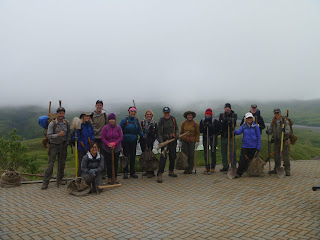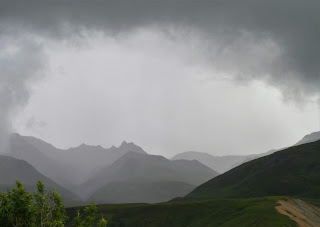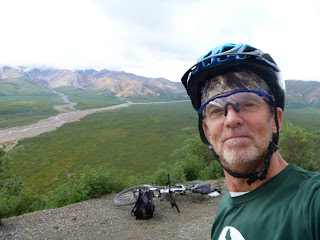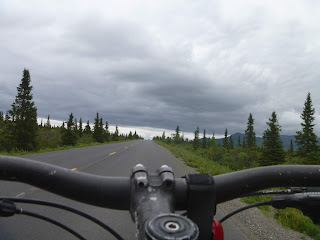
|
| 2017 Volunteer Trail Crew |

|
| 2018 Volunteer Trail Crew |

|
| 2019 Volunteer Trail Crew |
 |
| Denali National Park and Wilderness |
 |
| The "Closed Due to Bears" sign was put up while we were working on the trail. Nobody bothered to tell us. |
 |
| Even the forest service is impressed with our flagstone work |
 |
| Only 30% of park visitors actually see the mountain. |
 |
| Elevation profile |
From Eielson, there are basically five big climbs: Highway Pass, Polychrome Pass, Sable Pass, a sweet 10-mile downhill to the Teklanika campground, then the climb from the Sanctuary River over to the Savage River, another climb out of Savage and then downhill on the paved road to the entrance.
 |
| Looking to the west directly at Denali (obscured by clouds) near Stony Dome |
 |
| Fire Weed |
 |
| Caribou |
 |
| More caribou |
 |
| Sow grizzly and cubs |
 |
| Bear bell |
 |
| Polychrome Pass |
 |
| I met some bikers at Sable Pass. They took the bus shuttle up and planned to coast downhill 10 miles to their Teklanika campsite. |
 |
| Biking the Denali Park Road, aka Meals on Wheels |
The park service bus drivers like to humorously refer to bike riders as "Meals on Wheels" due to the large number of grizzly bears living in the park. While it is quite common to see grizzly bears, I was not overly worried. There are very few attacks in Denali N.P. and as of this writing there has only been one fatal bear attack in the park's 90-year history. Regardless, as I pedaled the remote gravel road slicing through Denali's wilderness, I could not help but contemplate my death at the jaws of an irritated grizzly. I often tell my wife and family that if I die in some remote wilderness doing something risky, they should remember I died doing something I love and as long I didn't die because I was stupid, they should conclude that I died well.
 |
| Avoid the stupid circle |
Avoiding death by stupidity is harder than most people realize. When I think back to the times in my life I narrowly escaped death, most include some element of stupidity.
My first brush with death occurred in the second grade. One morning my classmate, Richie, brought some "blanks" to school and generously handed them out to his classmates. We were all excited to receive such a wonderous gift. After all blanks often played a central plot point in our favorite TV programs such as Mission Impossible or The Man from U.N.C.L.E. After seeing Illya Kuryakin resurrected from a certain death because, surprise, the gun was loaded with blanks, we all understood that blanks were essentially harmless.
As soon as we were let outside for recess, we began trying to set off the "harmless" blanks by flinging them as hard as we could against the playground blacktop. Despite our best efforts, we were unable to get any of the blanks to explode before we were called back into class.
Later that day, the school principal appeared in my classroom and asked me to step into the hall. A cold shiver went down my back as I walked to the door. In the hallway, he asked me if Richie had given me anything. I dug the blank out of my front pants pocket, handed it to the principal, and waited to be led by the ear to the principal's office. Instead, the principal quietly told me to go back to class and it was never spoken of again.
As a second grader, I was amazed by the largesse of the principal. Being caught with such contraband and simply dismissed was staggering good fortune. Looking back, I realize two things. One, those were not "blanks." They were live ammunition. Why Richie thought they were blanks, we'll never know. Perhaps some misguided white lie by the gun owner. And two, the school principal must have been shitting bricks when he learned that a second grader was handing out bullets at school. He was not interested in discipline. He just wanted to collect those bullets and hope the whole incident would be quickly forgotten.
The next time I dodged a bullet, I was twelve, backpacking in Wisconsin's Newport State Park with a friend also named Pat. Situated at the tip of Door County, Newport is Wisconsin's only wilderness-designated state park and features hike-in campsites. Pat and I backpacked into the park, set up camp and then went out to explore.
Newport is a large park, so we were surprised to find that we were the only campers in the park. Another group had registered but left early. The reason -- the place was overrun by mosquitoes. They were so bad that when the ranger saw us approaching the park office, he opened the door and laid down a fog of suppressing insecticide outside the door. He then hustled us inside, immediately closed the door and fogged the interior as well.
When we realized it would be dark soon, we opted to take a short-cut back to camp rather than the jeep trail we hiked in on. Pat had the only flashlight. It was one of those "nifty" rechargeable flashlights with a plug built into the back and as the darkness closed in, the flashlight started to fade. Pat resorted to keeping the flashlight off and only turning it on when the way forward was unclear.
"We should have taken the jeep trail," I said to Pat as we blundered down the narrow hiking path barely visible in the gloom. His response was cut short as a distinct rattle cut through the darkness. Pat turned on the flashlight and illuminated in the faint yellow glow of a fading battery, was a massive Timber Rattlesnake curled up on the trail a few feet from our toes.
"Yaaah!" we said. The rattlesnake had much the same thought as it immediately slithered into the overgrowth. After waiting a few minutes to ensure that the snake was gone, we hiked back to our campsite without further trouble.
 |
| An aspiring backpacker |
When my father picked us up, we regaled him with our tales about the mosquitos, shortcuts and rattlesnakes. He nodded and laughed at our misadventures. When we repeated the stories to Pat's father, he became angry about our carelessness. The disappointment on Pat's face at his father's reaction is still clear in my mind.
During my junior high school years, my friends and I thought hitchhiking was a good way to get around as we were too old to ask for a ride from our parents and too young to drive ourselves. One summer afternoon at Deer Grove Forest Preserve, we stuck out our thumbs at the forest exit to get a ride home. A long-haired twenty-something guy in a big convertible pulled up.
"Hey man! I'm going on a beer run. I can only drive you dudes as far as the liquor store," he offered. We were too naïve to recognize that he was very drunk and we climbed in. Quentin Road in those days was very hilly and a no passing zone. That didn't deter our driver. He impatiently passed a car going up a hill. In the back seat I didn't see the near head-on collision, but I remember looking over my shoulder to see two cars in a cloud of dust spinning off the shoulder. Undeterred, the driver only paused at the red light.
"Left turn on red!" he declared and blew through the intersection. Fortunately, the liquor store was just down the street. We climbed out of the convertible a bit shaken, but uninjured.
Once I was old enough to drive, near-death by automobile continued with increasing frequency. The litany included being driven head-on into a tree by a drunk friend ("How did that tree get in the street?" -- Scott), investigating the top speed of a father's Mercedes Benz SEL ("121 mph" -- Ron), and waking up in the early morning light in the backseat of a car stuck in the mud ("You fuckers agreed if I drove home, you would keep me awake!" -- John). Most were alcohol-related, and alcohol massively increases the risk of death due to stupidity.
The episode that still chills my bones began with happy hour at Coogan's in downtown Chicago. After happy hour, a group of friends clambered into my rusted-out Volkswagen van for a ride to a party in the suburbs. The first clue that something was amiss was when I ended up on the sidewalk pulling a U-turn from street parking. Normally, the micro bus would make that tight turn no problem, but this day I had to drive around a telephone pole to complete the maneuver. Most of the passengers were still laughing as I drove down the ramp onto the Kennedy Expressway.
Driving on the expressway, I felt the steering was mushy and was clear-headed enough to pull off at Division Street.
"There's something wrong with my steering," I explained as I pulled into a gas station. The van's brain trust tumbled out and peered underneath the van to assess the situation.
"I can't see anything wrong." "It's too dark to see anything." "The van's not fucked up, but the driver is!" "Man, let's just keep going."
Reassured by our "thorough" safety check, I pulled back on the expressway. By Laurence Avenue, the steering was so poor I wondered if we would hit the guard rail at every turn. I pulled off again.
"I'm telling you, I can't steer." I announced with finality. The mood turned sober when we had to manually turn the front wheels to get the van to the curb.
The next morning, my father and I stood under the hoist as the mechanic explained that the steering column had rusted away from the front axle assembly.
"See, there's nothing holding the steering column in place," he said. "When I turn the wheel, the steering column just lurches around. You say you were driving on the Kennedy? Man, you must sit in the front pew every week at church."
The disquieting part of this story is, if I had hit the guard rail and killed everyone, they would have blamed drunk driving and never realized the steering had failed. I traded the van in for the price of the tow.
While trains are considered safer than cars, I've had brushes with death by train too -- like getting off at the wrong CTA stop on the wrong side of town in the middle of the night. The incident in question occurred in the daylight on an October morning just outside of Carbondale, IL. Ron and I were trying to hitch a ride into town to get breakfast. Across the street was a freight yard. All morning we had listened to a freight train moving back and forth as it hitched up the box cars and now it started to pull out of the freight yard heading into town.
"Let's jump the train," Ron suggested.
Having little luck hitching a ride, I agreed and we crossed the street to the freight yard. The train was moving at a walking pace. Ron clambered up the ladder of a tanker car without difficulty. I followed his example, but I grabbed the ladder too low. As I pulled myself up my legs swung under the carriage. My heart leapt as I felt certain my legs would be pulled beneath the wheels and crushed. Fortunately, my legs swung back out, and I quickly pulled myself onto the tanker car platform with my heart still in my throat.
At first the train ride was thrilling as we glided by the farms and fields. I then noticed that the speed of the train had picked up considerably. This train wasn't stopping in Carbondale -- it was headed cross-country.
"Ron, I think we should get off now," I yelled as we were clearly within the city limits by then.
"No, wait until we get all the way downtown," he replied.
"Sorry dude, the train's gaining speed. I'm getting off."
I slid over to the ladder, lowered myself down and dropped. Imagine going instantly from a standstill to your fastest sprint. My legs were suddenly flailing at top speed as I tried to come to a halt without falling flat on my face. My toes jammed against the front of my steel-toed boots during my deceleration.
"That was cool!" said Ron when he joined me. "Now I'm ready for some biscuits and gravy."
"Yea, cool. I think I broke my toes," I replied as I hobbled after him.
Young men think they're bulletproof. Apparently this risky behavior provides some evolutionary advantage. As men age, we become more cautious which saves a lot on car insurance, but the thinking is totally backwards. Old guys should be willing to take more risks as we have less to lose. If we die in our 60's, what have we lost: a lame retirement party, a decade puttering in the workshop, and then a few years watching golf and wearing slip-on shoes. The young are risking decades of experiences, marriage, travel, family. They should be wrapping themselves in bubble wrap, not jumping trains.
In 1982, the University of Illinois' Memorial Stadium was showing its age. As one of the oldest stadiums in the country, there were concerns about its structural integrity, but inspectors assured the university that everything was fine.
I was certainly unconcerned when I attended the Illinois-Purdue game that fall. It was a spirited contest with the lead trading back and forth. Each time Illinois would score, the full-house crowd would erupt with cheering and cause the upper deck start to shaking -- a lot! Our seats were below the upper deck towards the back. I was horrified to watch 10 rows of spectators across the way appear and disappear as the upper deck flexed up and down. The upper deck fans must have felt it too, as they quickly stopped cheering when the deck started to bounce. Once they quit, the steel cross beams above us would continue to vibrate for 20 seconds before shuddering to a stop. By the end of the game, we flinched any time Illinois was in scoring position.
"It was sooo scary," my sister recalled. In fact, both my younger sisters were at game and we discussed how awful it would have been for our parents if we all got crushed at once. But being in our 20s and bulletproof, we quickly shook it off in Kam's basement.
Subsequently, the university installed a bracing system to "eliminate spectator reports of discomfort due to the deflections." While the engineers pooh-poohed the risk, I heard that county officials had staged extra ambulances at the game. I don't know who was right, but it definitely was "sooo scary."
My wife, Mona, and I shared many adventures and it surprises me that there weren't more close calls. She will dispute this, but only one comes to my mind. We were vacationing in Mexico and a little bored with lounging on the beach. I proposed snorkeling along breakwater to see some sea creatures. It was an easy swim out and after observing many brightly colored tropical fish, we headed back to the beach. The seas were calm and the water so clear you could see the sea floor some 25 feet below. After swimming a few minutes, I noticed we hadn't made any headway.
"That's strange," I thought to myself. Concerned, I measured our progress using the sea floor as a reference. "Jeez, we're standing still." I realized we were in an invisible current trying to sweep us around the breakwater and out to sea.
"Swim faster," I called to Mona. I'm not sure she fully realized our predicament, but she responded, and we started to gradually make headway. At first, it was just inches at a time. As we got closer to the beach the effects of the current diminished and we broke free. We staggered onto the sand. I looked around. The rest of the guests were oblivious to our plight. If we had been swept around the breakwater, no one would have noticed until the end of the week when housekeeping wondered why we hadn't checked out.
My children also shared some close calls. My daughter, Lauren, and I were biking in Theodore Roosevelt National Park when we came across a herd of bison. The bison were in rut -- quite rowdy and noisy.
"They're following us down the road," Lauren called. I looked over my shoulder and so they were -- the whole herd.
 |
| Chased by a bison herd |
"Wait there and I'll take your picture with the herd in the background," I said as I pulled out my camera. Lauren waited nervously as the bison herd drew closer. I took the picture, and we quickly rode up the road to give the herd some space. Most of the animals ambled into the brush. One cow continued down the road drawing close to us as we stood just off the shoulder.
"Hey buffalo," I called to the bison hoping to reassure the animal that I was not a threat. It immediately squared off and faced me directly from across the road. I dropped my bike and scrambled up the hill to join Lauren who had already wisely retreated. After watching us for a few minutes, the bison concluded we weren't a pack of wolves and moved on.
 |
| "Hey buffalo" is the stupidest thing I've said to an animal since I walked up to a bear on a pitch-black night and said, "Hey Ron, is that you?" |
My son, Matthew, and I shared a close call as well. It was a father-son rim-to-rim backpacking trip in the Grand Canyon. We had descended to the lowest part of the canyon in an area called "the box," a narrow corridor enclosed by towering walls of an ancient geologic rock formation known as Vishnu Schist.
 |
| Matt hiking in "The Box" |
With Matt just ahead of me, we were crossing a bridge over Bright Angel Creek when a loud shot rang out.
Matt turned around, "What the hell was that?"
"Holy smokes! It was a falling rock!" I answered as I bent over and picked up the rock from where it had left a big divot in the bridge timber. On one edge I could see the chipped point where it struck the bridge and on the opposite edge, the unweathered facet of a fresh break. "This rock broke off just as we were walking by! And it landed between us! Man, that was close."
"Yea, that would have hurt," Matt said. "Maybe enough to crack a skull," he added looking at the divot in the bridge.
I pocketed the deadly projectile for later research. I was astonished when I learned the age of the Vishnu Schist. The rock had held for 1.8 billion years, though eons of tectonic forces, rivers, rain, snow, wind only to break free on a sunny May day just as two backpackers crossed the bridge below.
 |
| "When a 1.8 billion year old rock singles you out for assassination it might be time to wonder if the Universe is out to get you, and to act accordingly." -- Paul Frisbie |
Six hours into my bike ride, I had ridden as far as Savage River. I was totally gassed. At the trailhead parking lot, I sat on a bench, ate some trail mix, hydrated, and took a half-hour nap. Somewhat recovered, I mounted my bike for the last 15 miles. On the paved road at last, and with the last ten miles downhill, I was confident I would arrive in camp in time for dinner and, more importantly, today would not be my last.
 |
| We're on the paved road, almost there |
 |
| Left Eielson VC at 10 a.m., arrived to the front country admin camp around 6 p.m. |
 |
| Author before his accidental death falling from a train (just kidding). |
| State: | Alaska |
| Date: | 2018-08-03 |
| Route: | Denali Park Road, Eielson Visitor Center to Park Entrance |
| Distance: | 65 miles, +4,300, -6,400 |






